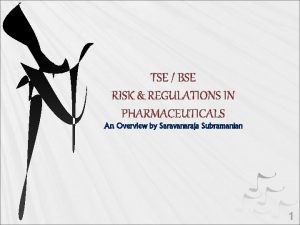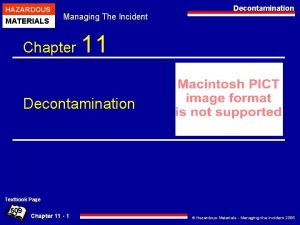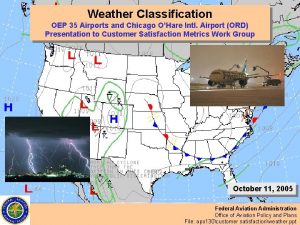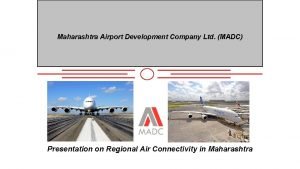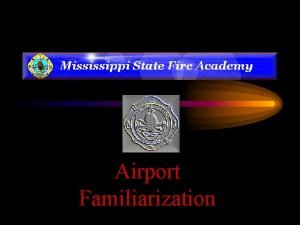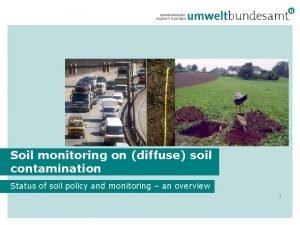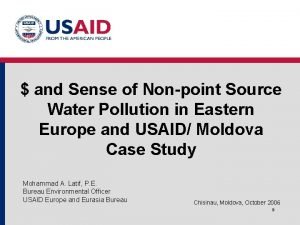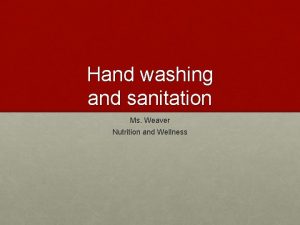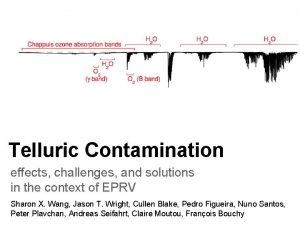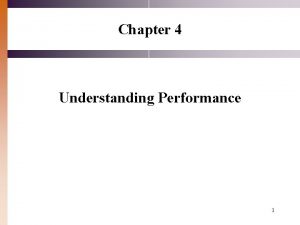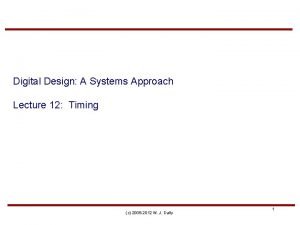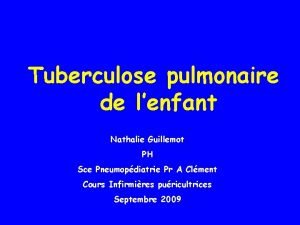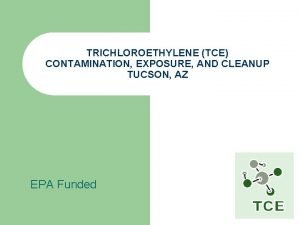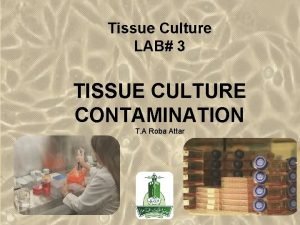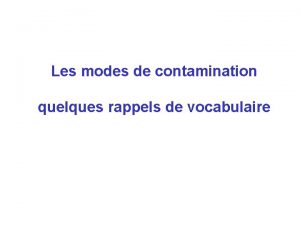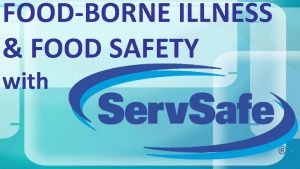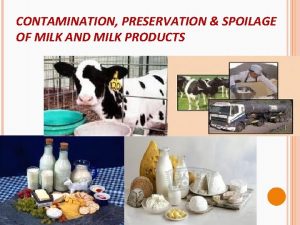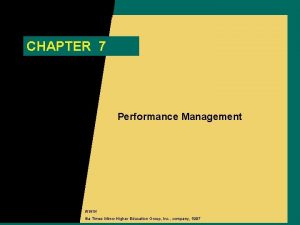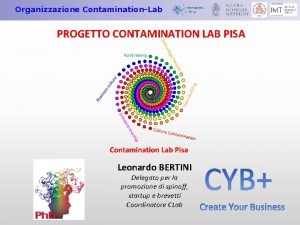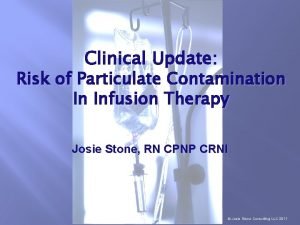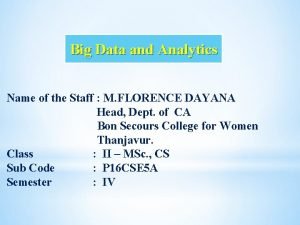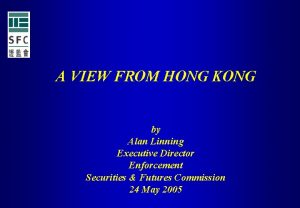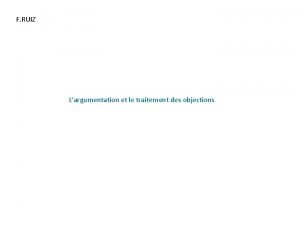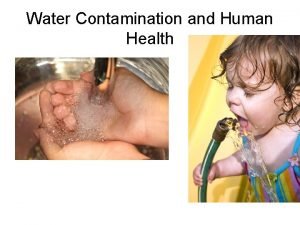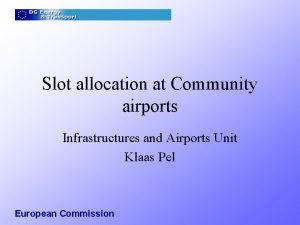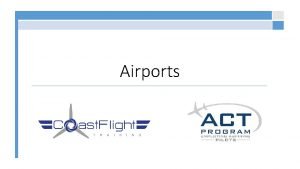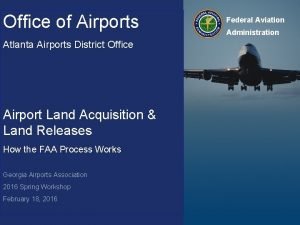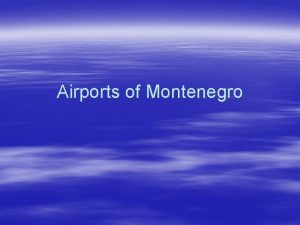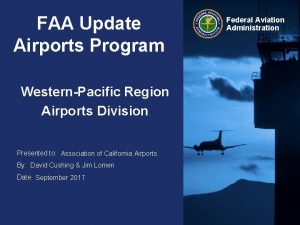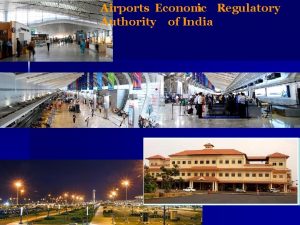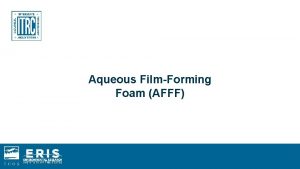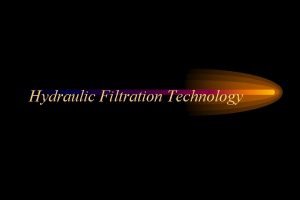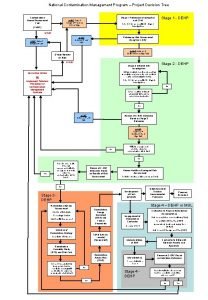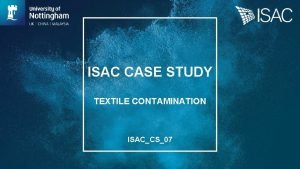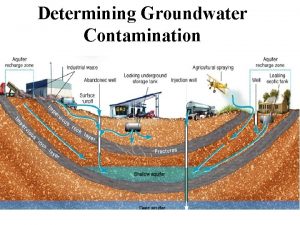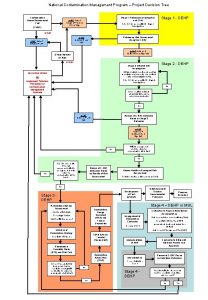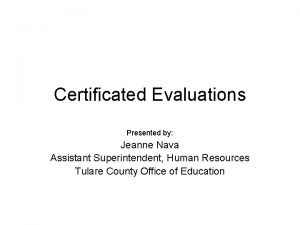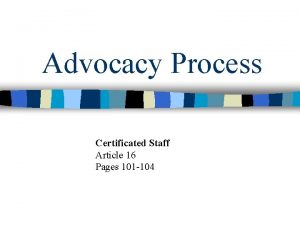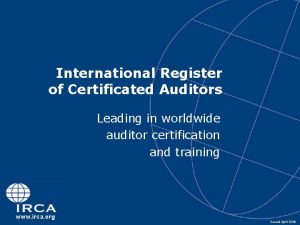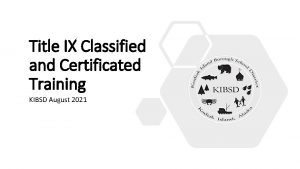Dealing with AFFF Contamination at Certificated Airports Ann




































































- Slides: 68

Dealing with AFFF Contamination at Certificated Airports Ann B. Richart, A. A. E. , Martha’s Vineyard Airport Ron Myrick, P. E. , Tetra Tech, Inc. Marty Judge, Flaster Greenberg PC March 27, 2019

Presentation Overview AFFF Use at Certificated Airports Ann Richart, A. A. E. Airport Director Martha’s Vineyard Airport PFAS Background and Regulatory Changes Ron Myrick, Jr. , P. E. Director of Remediation, Assessment and Compliance Tetra Tech, Inc. Legal Challenges and Strategies Marty Judge Chair, Environmental Law and Real Estate Departments Flaster Greenberg, PC

AFFF Use at Certificated Airports ANN RICHART, A. A. E, MARTHA’S VINEYARD AIRPORT

AFFF Development and Usage AFFF developed in the 1960 s for the US Navy ◦ Synthetic foam ◦ Spreads across the surface of hydrocarbon fuels ◦ Forms a water film which cools the liquid fuel and extinguishes the fire FAA mandated usage and testing at airports ◦ Foam tests typically required bi-annually per FAA Order 5280. 5 C (Airport Certification Program Handbook) ◦ NFPA 412 (Standard for Evaluating Rescue and Fire-Fighting Foam Equipment) ◦ Part 139 Cert. Alert – 1/17/2019: new AFFF testing methods without foam discharge were approved

AFFF Regulation & Use: Part 139 OR Index A Index B Index C Index D Index E 500 lbs dry chem OR 450 dry chem + water and AFFF to = 100 gallons 1, 500 gallons water and AFFF 3, 000 gallons water and AFFF 4, 000 gallons water and AFFF 6, 000 gallons water and AFFF

AFFF Regulation & Use: Part 139 During an annual or other inspection airport must: ◦ Within 3 minutes from time of alarm at least 1 vehicle must reach the midpoint of the farthest runway serving air carriers and begin application of extinguishing agent ◦ Within 4 minutes additional vehicles must do the same ◦ Within 6 months of the annual inspection airport must have documentation of testing of the foam proportioning and discharge functions ◦ Inspectors often require that AFFF be applied to the ground during the inspection to meet this requirement

AFFF Regulation & Use: Part 139 New guidance and inspector flexibility suggest that AFFF testing may be done: With or without the inspector present At a location with AFFF containment facilities Using testing systems which don’t require external discharge

AFFF Regulation & Use: Part 139 By following new guidance AFFF discharge to the ground for testing purposes can be eliminated ◦ ALL airports should make this transition immediately In case of an actual aircraft incident AFFF must be applied in appropriate amounts at the scene Any past discharge of AFFF on the ground for testing or training purposes is probably contaminating the groundwater in the vicinity now or for an aircraft incident

Martha’s Vineyard Airport

Martha’s Vineyard Airport

Martha’s Vineyard Airport ◦ ARFF Index A (with seasonal Index B ops) ◦ Popular vacation destination due to rural nature of island ◦ Upscale homes ◦ ◦ Wealthy Educated Retired Environmentally conscious ◦ Former Naval Air Station ◦ Past history of PCE groundwater contamination

MVY PFAS Experience: Why Did We Start Looking at PFAS? 20 year cleanup of PCE contamination to private wells completed in Fall, 2017 Ongoing concerns from neighbors about ◦ Airport noise ◦ Expansion of airport facilities and operations 2016 discovery of PFAS in community water supply in Barnstable (Hyannis) Draft PFAS guidance was published by the Commonwealth in early 2017

MVY PFAS Experience February 2018: Began studying PFAS contamination on airport property October 2018: Sampled select private wells December 2018: Began outreach to neighbors and broader sampling of private wells and beginning of Mass. DEP compliance activities January 2019 - present: Off airport efforts continue. . . mostly related to drinking water

MVY PFAS Experience ◦ January 2019 construction began on main runway rehabilitation ◦ Since Mass. DEP already had our information showing that AFFF had been discharged on the runway we were required to analyze soil that was excavated ◦ Still not clear whether this extra project work will be AIP eligible

FAA Experience December 2018 met with FAA and discussed findings to date: ◦ Were initially told costs associated with ◦ FAA has agreed that off airport contamination research, testing, analysis and remediation testing and remediation is an appropriate use were not appropriate uses of “airport revenue” of “Airport Revenue” but is not AIP/PFC eligible ◦ Were told that Part 139 continues to require ◦ January Cert Alert recommends AFFF testing airports to “show foam” during inspection be done without discharging to ground ◦ Were warned to use adequate amounts of ◦ Tech Center has begun research on substitute AFFF in the event of an aircraft incident AFFF formulations

Public Perception Public is aware that FAA/EPA/State guidance and regulation is AFFF is lacking MVY is receiving VERY positive feedback from the public for taking action despite lack of regulation Industry SHOULD be in a position to work WITH regulatory partners on these challenging issues

Ongoing Airport Concerns ◦ We have Environmental Pollution insurance. . . don’t know what may be covered ◦ Ongoing expenses may be HUGE with no assurances of funding ◦ Once regulation is established what if we’ve taken wrong/insufficient action ◦ What don’t we know? ? ?

Advice to Colleagues ◦ Every Part 139 Airport with neighbors on well water will be impacted ◦ Every Part 139 Airport that excavates soil on the airfield will be impacted ◦ Start NOW mapping known AFFF release areas from both testing and aircraft incidents ◦ IMMEDIATELY institute operational methods of testing AFFF without discharging to the ground ◦ Research insurance options ◦ Watch for regulatory changes on both the Federal and State level ◦ Begin talking with your legal advisors about pros and cons of beginning study of PFAS on your airport

PFAS Background and Regulatory Changes RON MYRICK, JR. , P. E. , TETRA TECH, INC.

PFAS Background and Regulatory Changes Ron Myrick, Jr. , P. E. , Tetra Tech, Inc. PFAS Background Recent PFAS Regulatory Changes AFFF Development and Usage Assessing for AFFF Impacts in the Environment AFFF Best Management Practices Case Study – MVY Airport

PFAS Background ◦ Manufactured since the 1940 s ◦ Very stable compounds ◦ Water soluble and mobile in groundwater ◦ Bioaccumulate ◦ Some PFAS compounds determined to be toxic with high concentrations and/or long-term exposure: ◦ Developmental effects in fetuses ◦ Likely impacts to thyroid, liver, kidneys, hormone levels and the immune system ◦ Possible cancer risk

Where are PFASs found? PFASs are present in numerous everyday products and supplies ◦ Teflon (e. g. non-stick cookware) ◦ Waterproof textiles (e. g. Tyvek, Gore. Tex) ◦ Scotchgard, Stainmaster and other stain/water proofing products ◦ Waxes (e. g. ski, automotive, floor) ◦ Food wrappers (e. g. , fast food containers and wraps, pizza boxes) ◦ Microwave popcorn bags ◦ Dental floss ◦ Shampoos/sunscreens/moisturizers/insect repellents ◦ Cosmetics ◦ AFFF – Fighting petroleum fires (Class B Foam)

Recent Regulatory Changes i s. R s e r dd o. A t p ing U tion r a e es G tamina i c n Age AS Con F by P d se o P s sk Toxic ‘ Fami Forever C lies R h eelin emicals’ g in Dr inkin g Wa ter Le ad re p s e id EPA Che Says It mic als, Plans T o But Not Limit T Soo o n En xic PF oug AS h Fo r Cr it r. W o f e ics lam B o mt n a o ng F inatio i t h fig am Fire r Cont e Wat ave M ilitary

Recent Regulatory Changes ◦ PFAS are “emerging contaminants” ◦ No current enforceable standards exist for PFAS compounds in drinking water in most states…however ◦ May 2016: USEPA issued a Health Advisory of 0. 070 ug/L for 2 PFAS compounds – PFOS and PFOA (70 parts per trillion or ppt) ◦ State regulatory agencies have responded with guidance values or promulgated standards in several northeastern US states

Current PFAS Regulatory Guidance and Standards for Groundwater Federal Heath Advisory (FHA): 70 ppt (PFOS + PFOA)* 70 ppt (PFAS + PFOA + PFHx. S + PFHp. A + PFNA) ◦ CT ◦ MA* 70 ppt (PFOS + PFOA) ◦ RI 38 ppt (PFOA)*; 70 ppt (PFOS)*, 70 ppt (PFOA + PFOS); 85 ppt (PFHx. S)*, 23 ppt (PFNA); ◦ NH 20 PPT (PFAS + PFOA + PFHx. S + PFHp. A + PFNA)* ◦ VT 13 ppt (PFNA)*; 13 ppt (PFOS)*; 14 ppt (PFOA) ◦ NJ *Health advisory, guidance, or proposed regulatory value FHA only ◦ DE ◦ MD ◦ NY ◦ PA ◦ DC

I created an alternative slide under this one. Use which ever one you prefer. -- Arianne AFFF (Aqueous Film Forming Foam – Class B) How does AFFF enter the environment? Through FAA-Required Testing and Usage of AFFF Directly to the ground surface ◦ Residual source remains in soil ◦ Groundwater impacts Into storm drain systems to discharge locations ◦ Surface water impact ◦ Infiltration into soils as a residual source and groundwater impacts Storage locations for AFFF

AFFF (Aqueous Film Forming Foam – Class B) How does AFFF enter the environment? Through FAA-Required Testing and Usage of AFFF Directly to the ground surface ◦ Residual source remains in soil ◦ Groundwater impacts Into storm drain systems to discharge locations ◦ Surface water impact ◦ Infiltration into soils as a residual source and groundwater impacts Storage locations for AFFF

Recommended AFFF Management Practices ü Avoid use of older “Legacy” AFFF formulations (pre-2003) which present highest concern ◦ Most toxic ◦ Long shelf life ◦ Take-back programs for “legacy” AFFF ü Capture and contain AFFF test liquids ◦ Impervious surfaces and containment areas ◦ Recover and properly dispose of AFFF liquids ◦ Assess and remediate source soils in testing and storage area ü Use recently-approved AFFF testing systems ◦ FAA Part 139 Cert Alert (1/17/2019) ◦ No AFFF discharge testing approved ◦ Eco-Logic system from E-one ◦ No. Foam System ◦ Oshkosh ECO EFR (Electronic Foam Proportioning) System ü Regulatory standards are imminent ◦ Investigate suspected release areas now ◦ Identify possible receptors ◦ Implement containment/capture/treatment to mitigate impacts

Assessing for AFFF in the Environment 1. Historical research o AFFF formulation testing areas o Equipment flushing areas o Fire suppression events (test or real) o Drainage system outfalls o AFFF storage areas 2. Install & sample monitoring wells o At and downgradient of suspected AFFF release areas o Approaching sensitive receptors including water supply wells 3. Sample water supply wells o Downgradient of AFFFimpacted monitoring wells

Case Study – MVY Airport Tetra Tech retained to initiate a voluntary assessment of potential PFAS impacts at MVY from AFFF in January 2018 ◦ Interviews and research regarding past AFFF usage ◦ Drilling to assess soil and install groundwater monitoring wells at historic AFFF testing or usage areas ◦ Groundwater sampling of new and existing monitoring wells ◦ Development of AFFF Management Plan Mass. DEP issued PFAS long-term drinking water guidance in June 2018 (70 ppt as the sum of 5 target PFAS) ◦ Exceedance of guidance value in monitoring wells at MVY Further assessment of MVY and in downgradient target study area initiated in October 2018 ◦ Targeted additional monitoring well sampling ◦ Residential well sampling

Case Study – MVY Airport

Private Well Sampling Results Summary (124) private wells sampled and reported to date ◦ Detected target 5 PFAS p to 1, 358 ppt ◦ (14) results exceed MA guideline of 70 ppt ◦ (14) results between 20 ppt and 70 ppt

Point-of-Entry Treatment Systems Point-of-Entry treatment systems ◦ (2) 12” x 42” upflow type polyethylene vessel with 55 pounds of granular activated carbon (GAC) connected in series ◦ Cartridge sediment filter ◦ Flow totalizer ◦ Proven effectiveness and readily-available technology ◦ Installations planned winter/spring 2019

Initial Treatment System Install & Test

Initial Treatment System Install & Test

Long Term Plan Eliminate PFAS sources at the Airport ◦ AFFF ◦ Other PFAS sources Mitigate further off-site migration toward private wells ◦ Pumping along southern MVY border ◦ Treatment and on-site discharge of groundwater Long-term operation and monitoring of private well treatment systems ◦ Performance sampling ◦ Replacement of activated carbon treatment media, as needed

Legal Challenges and Strategies MARTY JUDGE, FLASTER GREENBERG, PC

PFAS contamination is widespread in the USA ◦ At one time all but ignored, PFAS contamination in the environment is now known to be widespread and the number of identified PFAS sites keeps expanding all of the time. ◦ Two most widely known PFAS chemicals are perfluorooctanoic acid (PFOA) and perfluorooctane sulfate (PFOS). ◦ PFOA and PFOS are main PFAS components of Aqueous Film Forming Foam (AFFF), which is the principal source of such contamination associated with airports. ◦ Outside of airports, a number of firefighting training sites have also been identified as AFFF sites.

PFAS contamination is widespread in the USA ◦ A Northeastern University ongoing study finds at least 94 industrial or former/present military sites containing confirmed PFAS in the USA at this time. ◦ But, that number is certain to be understated, as it excludes other categories of PFAS contamination sites, and more sites are being identified all the time. Notably missing from the Northeastern study are all but a handful of currently non-military airports. ◦ The Northeastern study link follows: https: //www. northeastern. edu/environmentalhealth/mapping-the-expanding-pfas-crisis/

PFAS contamination is widespread in the USA The Northeastern University study links to an interactive map showing currently known PFAS industrial and military sites. They are heavily concentrated along the East coast (especially the Northeast), in the Midwest, and on the West coast:

PFAS contamination is widespread in the USA 4 Of the 94 PFAS sites listed in the Northeastern University study, 25 presently involve airports located in the NEC/AAAE Territory, and all are identified as AFFF sites: ◦ DE: 3 sites ◦ MA: 3 sites (excludes Martha’s Vineyard) ◦ ME: 4 sites ◦ NH: 3 sites ◦ NJ: 2 sites ◦ NY: 6 sites ◦ PA: 3 sites ◦ VT: 1 site 1 3 3 6 3 2 3

PFAS contamination is widespread in the USA ◦ Outside of airports and other AFFF sites, many PFAS releases come from the use of PFAS as raw materials in manufacturing operations, plus the production of PFAS chemicals themselves by chemical companies. Such sites are typically known as non-AFFF sites. ◦ Chemical companies, like Du. Pont (now Chemours) and 3 M, were major manufacturers of PFOA for decades. 3 M was once the only manufacturer of PFOS in the USA. ◦ Non-AFFF sites attributable to chemical companies have been responsible for some of the largest liability settlements for PFAS contamination to date. For example…

Some PFAS settlements have been enormous! In a multi-district federal litigation (MDL) docketed in Ohio, Du. Pont and Chemours agreed in early 2017 to a $670. 7 million settlement of about 3, 550 lawsuits related to personal injury claims arising from environmental releases of PFOA from Du. Pont’s Washington Works plant in Parkersburg, West Virginia. Half of the settlement was paid by Chemours, and the other half was paid by Du. Pont. Both companies denied any wrongdoing. $ $ Chemours Du. Pont

Some PFAS settlements have been enormous! ◦ And in early 2018, the State of Minnesota and 3 M entered into a settlement of the State’s claims for natural resource damages (NRD) caused by 3 M’s release of both PFOS and PFOA into the environment. ◦ The total settlement was for $850 million. This was one of the largest NRD recoveries in USA history, and it is believed to be the largest settlement for PFAS contamination. ◦ Although the settlement was large, Minnesota’s original damages claim was actually for > $5 billion. ◦ What’s more, this settlement was only for NRD. It was not for the actual costs to remediate the contamination itself. Natural Resource Damage (NRD) Settlement $ $850 billion settlement

Claims for PFAS contamination have been increasingly targeting airports ◦ PFAS claims against airports have not approached those mentioned above (yet). But claims against airports have been increasing in frequency, and have accelerated in the last few years. This is mainly due to the use of AFFF that contains PFOA and PFOS. ◦ The increase of such claims cannot be absolutely verified without reviewing many thousands of lawsuits, and even that would exclude non litigation claims that have been settled. However, anecdotal evidence and other observations show that this is happening. ◦ Martha’s Vineyard Airport is a good example of this.

Examples of PFAS contamination claims involving airports A boolean logic search for “(PFOS or PFOA or PFAS) and AFFF” conducted recently on Westlaw turned up references to a number of lawsuits where drinking water supplies have allegedly been contaminated by PFOA and PFOS coming from AFFF at airports. The cases involve the following states and airports: ü CO: Peterson Air Force Base ü FL: Pensacola Naval Air Station ü MA: § Barnstable Municipal Airport § Westfield-Barnes Regional Airport ü NY: Gabreski Airport. ü PA: § Willow Grove Naval Air Station § Naval Air Warfare Center at Warminster

Examples of PFAS contamination claims involving airports ◦ Also, in In re: Aqueous Film Forming Foam Products Liability Litigation, ___ F. Supp. 3 d ___, 2018 WL 6427189 (US Judicial Panel on Multidistrict Litigation, December 7, 2018), the federal MDL panel recently consolidated 75 pending actions containing claims related to alleged AFFF releases mostly from airports. ◦ The 75 consolidated cases were originally filed in Colorado, Delaware, Florida, Massachusetts, New York, Pennsylvania and Washington. ◦ However, the court declined to consolidate 9 more non AFFF cases that were originally filed in Alabama, Michigan, Minnesota, and New York.

Airports have not been immune from PFAS litigation ◦ Nature of claims brought against airports varies from case to case. ◦ But typically there is a personal injury claim (e. g. , requests for medical monitoring; compensatory damages, etc. ) due to alleged ingesting of PFOS and/or PFOA in drinking water. ◦ Also common are: ◦ Property damage claims for loss of use of wells or contamination of surface waters used to supply potable water. ◦ Claims to compel or reimburse for installation of Point of Entry Treatment (POET) systems to de-contaminate drinking water wells. ◦ And sometimes loss of property value claims due to proximity to airports or for “stigma damages” where a home or business sits on top of contaminated groundwater.

Airports have not been immune from PFAS litigation Important recent case: Giovanni v. United States Department of Navy, 906 F. 3 d 94 (3 d Cir 2018), concerns PFOS and PFOA contamination in groundwater and surface water from decades of AFFF use at the Willow Grove Naval Air Station and Naval Air Warfare Center at Warminster, Pennsylvania: ◦ Federal appeals court ruled that plaintiffs could maintain a medical monitoring claim against the Navy for PFAS exposure even though Navy, through ongoing cleanup actions, was already remediating PFAS as part of the site’s existing status as a Superfund site for non-PFAS contaminants. ◦ However, court denied claim for a public health effects study on technical legal ground that carrying out such a study would interfere with Navy’s ongoing cleanup efforts and, thus, this relief was prohibited under federal law.

Federal Regulatory Oversight Has Been Slow Coming Current state of federal regulation of PFAS by USEPA is sparse and has rightly been criticized: ◦ USEPA has failed to act in a thorough and comprehensive manner to date. So far, it has only issued a non-binding Health Advisory of 0. 070 ug/L (70 ppt) for PFAS compounds – PFOS and PFOA – on a combined, but not individual, basis. ◦ USEPA has not, to date, declared any PFAS compound a “hazardous substance” for purposes of CERCLA (i. e. , the Superfund law) jurisdiction. ◦ USEPA has not, to date, adopted any Maximum Contaminant Level (MCL) for a PFAS compound under the federal Safe Drinking Water Act (SDWA). ◦ USEPA has no current regulatory standards for the remediation of PFAS in soil, groundwater or surface water.

Federal Regulatory Oversight Has Been Slow Coming On February 14, 2019, USEPA announced its long awaited action plan to manage PFAS substances in the United States. Major features include: Establishing a binding drinking water standard under the SDWA for PFOA and PFOS. Listing PFOA and PFOS as “hazardous substances” under CERCLA. Using the agency’s enforcement authority to require the remediation of soil or groundwater contaminated with PFAS above USEPA’s existing health advisory levels of 70 ppt. Continuing to assess the potential health effects associated with PFAS, including so-called “second generation” PFAS.

Federal Regulatory Oversight Has Been Slow Coming However, notwithstanding these actions by USEPA, full federal regulation of PFAS is still years away: ◦ Amending CERCLA’s “hazardous substance” list will require a formal regulatory change. This could take as long as a year or two, if USEPA acts swiftly. ◦ Establishing MCLs under the SDWA for PFOA and PFOS is at least several years away. In fact, despite USEPA’s promise that it will set MCLs, it must first make regulatory determinations that the PFAS substances in question even pose a health risk, before it can act further. USEPA only projects taking this first step in late 2019. After, the more difficult phase will occur, which is to come up with scientifically supportable MCLs. = 1+ = Year Several Years

I cleaned this up more on the next page… I kept it as is though if you want to keep this version… --Arianne States Have Been Increasingly Acting In USEPA’s Void (Earlier Slide) Federal Heath Advisory (FHA): 70 ppt (PFOS + PFOA)* ◦ CT: 70 ppt (PFAS + PFOA + PFHx. S + PFHp. A + PFNA) ◦ DE: FHA only ◦ MD: FHA only ◦ MA: 70 ppt (PFAS + PFOA + PFHx. S + PFHp. A + PFNA)* ◦ NH: 38 ppt (PFOA)*; 70 ppt (PFOS)*, 70 ppt (PFOA + PFOS); 85 ppt (PFHx. S)*, 23 ppt (PFNA); NJ: 13 ppt (PFNA)*; 13 ppt (PFOS)*; 14 ppt (PFOA) NY: FHA only PA: FHA only RI: 70 ppt (PFOS + PFOA) VT: 20 PPT (PFAS + PFOA + PFHx. S + PFHp. A + PFNA)* DC: FHA only ◦ ◦ ◦ *Health advisory, guidance, or proposed regulatory value

States Have Been Increasingly Acting In USEPA’s Void (Earlier Slide) Federal Heath Advisory (FHA): 70 ppt (PFOS + PFOA)* 70 ppt (PFAS + PFOA + PFHx. S + PFHp. A + PFNA) ◦ CT ◦ MA* 70 ppt (PFOS + PFOA) ◦ RI 38 ppt (PFOA)*; 70 ppt (PFOS)*, 70 ppt (PFOA + PFOS); 85 ppt (PFHx. S)*, 23 ppt (PFNA); ◦ NH 20 PPT (PFAS + PFOA + PFHx. S + PFHp. A + PFNA)* ◦ VT 13 ppt (PFNA)*; 13 ppt (PFOS)*; 14 ppt (PFOA) ◦ NJ *Health advisory, guidance, or proposed regulatory value FHA only ◦ DE ◦ MD ◦ NY ◦ PA ◦ DC

Legal Effects Of Stronger Federal PFAS Regulation In The Future Eventual CERCLA regulation of PFAS contaminants will likely impose new liabilities on airports, for which few defenses would seem to be available: ◦ As the “owner” or “operator” of a site where a “release” of a “hazardous substance” has occurred, the airport will become strictly, jointly and severally liable for the remediation of all PFAS substances listed as “hazardous substances” on, in or beneath its property, as well as at any location to which the substances may have migrated. ◦ Aside from potential liability for “removal” or “remediation” costs, a party who is responsible under CERCLA for PFAS releases could also be sued for NRD in an appropriate case. ◦ Statutory CERCLA defenses like the “innocent purchaser” defense, the “bona fide prospective purchaser” defense, and the “contiguous property owner defense” are unlikely to be available (because of an airport’s own use of AFFF, among other reasons).

Legal Effects Of Stronger Federal PFAS Regulation In The Future Eventual CERCLA regulation of PFAS contaminants will likely impose new liabilities on airports, for which few defenses would seem to be available (continued): ◦ Other CERCLA defenses like acts of God, acts of war, or acts or omissions of third parties with whom a liable party has no contractual relationship are also unlikely to be available for various reasons. ◦ At present there is no known defense that would immunize an airport from liability based on the Federal Aviation Agency’s (FAA) mandated use of AFFF containing PFAS. CERCLA does contain something called the “federally permitted release” defense, which is described in 42 U. S. C. § 101(10). However, the gist of that defense is that the discharge must have been permitted under one of several specific types of water pollution permits or in similarly described situations where the permits themselves were designed to protect the environment. It is questionable whether FAA’s mandated use of AFFF meets these criteria, as it has fire suppression, and not environmental protection, as its primary goal. This is not to say that Congress could not still amend the law to create such a defense, of course.

Legal Effects Of Stronger Federal PFAS Regulation In The Future On the other hand, eventual CERCLA regulation of PFAS would also give present airport owners more clear cut rights to seek reimbursement from others for PFAS contamination that current owners may be forced initially to clean up alone: ◦ For example, proof that a predecessor airport owner – e. g. , the Department of Defense (DOD) – used AFFF and released PFAS into the environment in the past that the current owner is now forced to clean up might support a claim for contribution under CERCLA against the prior owner to help offset the present owner’s costs. It is unclear that such a claim would exist under the current regulatory status of PFAS, at least under federal law. ◦ However, the extent of a contribution claim is innately imprecise, because it depends on a comparison of the liability of one liable party to that of another, and whether the claimant’s costs exceed its “fair share” for all remediation costs taken together.

Legal Effects Of Stronger State PFAS Regulation In The Future In addition to potential CERCLA liability, airports might also now or in the future face similar liability under various state “mini Superfund” statutes: ◦ Many states have such laws on the books, although liability is normally dependent upon proof of a “release” or “discharge” of a “hazardous substance” into the environment. Therefore, a prerequisite to liability would be each state must first declare pertinent PFAS contaminants to be “hazardous substances” under its own mini Superfund law. So far, most have not done this. However, it is a sure bet that they will. ◦ Examples of such laws include New Jersey’s Spill Compensation and Control Act, N. J. S. A. 58: 10 -23. 11 et seq. , and Pennsylvania’s Hazardous Sites Cleanup Act, 35 P. S. § 6020. 101 et seq. ◦ Typically, such statutes provide for liability similar to CERCLA (including potential NRD liability) as a matter of state law, together with similarly limited defenses. Most such laws also allow the right to assert contribution claims against other liable parties.

Legal Effects Of Stronger State PFAS Regulation In The Future Aside from potential CERCLA and state mini Superfund liability, traditional state common law claims are also now, and will likely still in the future be, available to claimants in appropriate cases: ◦ Such claims might be for alleged negligence, nuisance (both private and public), trespass, and even carrying out an abnormally dangerous activity under appropriate facts. ◦ Claims can also be brought under a court’s inherent equitable power to force a liable party to clean up contamination for which it is legally responsible if it fails to do so voluntarily. ◦ Many of the cases that have already been filed for both AFFF and non-AFFF type claims are based on common law causes of action like the above, in the absence of clear statutory designation of PFAS compounds as “hazardous substances” under CERCLA or state analogues to date. See, again, the Giovanni case concerning the Willow Grove naval site, previously discussed.

Legal Effects Of Stronger State PFAS Regulation In The Future Other state laws, unique to individual states, may also authorize a state agency to force an airport to take action even in the absence of CERCLA amendment or a mini Superfund amendment to cover PFAS materials as “hazardous substances”: ◦ For example, in New Jersey, its Water Pollution Control Act, N. J. S. A. 58: 10 A-1 et seq. , broadly prohibits the “discharge” of any “pollutant” without the polluter first obtaining a state or federal water discharge permit. “Pollutant” is defined as: “any dredged spoil, solid waste, incinerator residue, sewage, garbage, refuse, oil, grease, sewage sludge, munitions, chemical wastes, biological materials, radioactive substance, thermal waste, wrecked or discarded equipment, rock, sand, cellar dirt, and industrial, municipal or agricultural waste or other residue discharged into the waters of the State. ‘Pollutant’ includes both hazardous and nonhazardous pollutants. ” ◦ This definition arguably already covers AFFF foam after it has been used for fire suppression or training purposes and PFAS materials, as a residue or waste, have been released into the ground. Other states may have similar laws.

The $64, 000 Question Should an airport voluntarily look for PFAS contamination on its property, or should it wait until some external force compels it to act? ◦ ◦ ◦ There is no “one size fits all” answer. Every airport will need to evaluate its own circumstances and make this decision for itself. What may be right for Airport X could be wrong for Airport Y. Obviously, if there is a legal obligation to act, then the airport must act. But in considering whether to act voluntarily, it is important to be aware of some facts: ◦ The likelihood of there being PFAS contamination in the soils, groundwater and even surface water at or surrounding any airport is very high, to the point of virtual certainty. This is because every airport has been compelled to use AFFF, and the foam did contain PFAS compounds. Therefore, if you look for PFAS in the right place, you will probably find it. The major issues will be the location of the contaminants and their level of strength or severity. ◦ Most states have “reportable discharge laws. ” This is also a federal requirement under CERCLA (and in some other statutes). This means that if an airport decides to sample for PFAS and finds evidence of its past discharge on its own property, that must be promptly reported to the appropriate state environmental agency and to the USEPA. Once the report is made, the site will be forever identified as a known contaminated site, which means it is only a matter of time before the airport will in fact need to address the contamination.

The $64, 000 Question Should an airport voluntarily look for PFAS contamination on its property, or should it wait until some external force compels it to act (continued)? But in considering whether to act voluntarily, it is important to be aware of some facts (continued): ◦ ◦ Even in the absence of an airport’s self identification as a site containing PFAS contamination, for all but the most isolated airports it will probably only be a matter of time before someone connects the dots and the airport will face remediation obligations connected to the PFAS. In more developed areas, this could be because a public drinking water system has become contaminated and a water purveyor using that water has to find a way to provide noncontaminated drinking water to its customers. (E. g. , Willow Grove. ) In less developed areas, it could be impacts to individual wells compelling the installation of POET systems. (E. g. , Martha’s Vineyard. ) No matter what the status is for nearby water supplies, all remediations need to include some kind of “source control, ” which basically means finding and addressing the location(s) on the site where the discharges originally occurred and where the PFAS contaminants are still leaching into water bodies. Any ground or surface water remediation that does not tackle source control first will never fully clean up the contamination in the water, and will waste a lot of time and expense. Meanwhile, the contamination will continue to spread.

The $64, 000 Question Should an airport voluntarily look for PFAS contamination on its property, or should it wait until some external force compels it to act (continued)? ◦ Public relations with the surrounding community have their place, and are or can be an important factor in whether, and if so when, an airport should act. The same for any overall sense of morality or “doing the right thing” under the circumstances. These factors could be reasons alone to commence a PFAS investigation and remediation, as necessary. ◦ There may be a difference in perception, and even legal obligation, between the obligations to the community of a public airport – which could be subject to Freedom of Information Act and open public meeting laws – and privately owned airports that have no such obligations, or the disclosure obligations are reduced. ◦ Acting sooner to address possible PFAS contamination, especially in carrying out source control, might save future response costs over time, because as noted above, removing the source effectively stops the spread of the PFAS contamination away from that location.

The $64, 000 Question Should an airport voluntarily look for PFAS contamination on its property, or should it wait until some external force compels it to act (continued)? ◦ On the other hand, treatment technologies to remediate PFAS contamination, both in the soils and in nearby water bodies, might be expected to improve over time, not only in their efficacy in removing the contaminants but also in overall costs. For instance, is there a naturally occurring bacteria whose DNA could be “engineered” to quickly and cheaply strip PFOA and PFOS from soil or groundwater, leaving no residual contaminants in its place? ◦ To the extent an airport has third party liability insurance that may (or may not) cover it for a situation like this, such as modern Pollution Liability coverage, virtually all such policies require the existence of a third party “claim” (typically, a lawsuit; a notice of claim; an administrative order or directive; etc. ) as a trigger for the carrier’s duty to provide coverage. A purely voluntary PFAS remediation might not be enough to trigger coverage. However, it must be noted this is a complicated and state specific area of the law, and what may be accepted as a triggering event in one state may not be different in another.

The $64, 000 Question Should an airport voluntarily look for PFAS contamination on its property, or should it wait until some external force compels it to act (continued)? ◦ Consideration also needs to be given to the impact that the current uncertainty about federal and state MCLs and other cleanup standards could have on the decision at hand. This seems especially true if the airport is located in a state that has not yet acted to promulgate its own standards and is, at least for now, relying on USEPA’s non-binding 70 ppt standard for PFAS in drinking water. No doubt this number will become more stringent, but it cannot be determined where it will end up. If a remediation is performed to the existing federal standard and later USEPA or the state lower that number, will there be inefficiencies and duplications of costs at the end of the day that could have been avoided if the airport could have factored a lower standard into the remediation work plan from the start? ◦ However, in a jurisdiction that has already set, or is about to set, its own cleanup standard that is enforceable at the state level, a party carrying out a remediation in that state may have a better chance of being able to predict future and final cleanup costs.

The $64, 000 Question Should an airport voluntarily look for PFAS contamination on its property, or should it wait until some external force compels it to act (continued)? ◦ Finally, any airport located in a state where the local authorities are, or threaten to be, moving forward aggressively with things like setting MCLs and other standards for PFAS, amending their own laws to specifically list some PFAS compounds as “hazardous substances, ” etc. might consider opening an early dialogue with the state about starting the process of conducting a PFAS investigation and, as necessary, remediation on its property on a voluntary basis, instead of awaiting receipt of a state enforcement document requiring it to act. Depending on the state, there may be local statutory protections that do not exist on the federal level that partially immunize a remediating party from certain costs. The state may also have available a public assistance fund that could provide grants or loans to the airport to help reduce the remediation costs. And in some jurisdictions, the state may be willing to work cooperatively with a remediating party like an airport in issuing enforcement documents to co-responsible parties (e. g. , the DOD; other predecessors, another nearby PFAS source) that could be helpful in attempting to obtain reimbursement for some costs.

QUESTIONS? Ann Richart, A. A. E. Martha’s Vineyard Airport Ron Myrick, Jr. , P. E. Tetra Tech, Inc. Marty Judge Flaster Greenberg, PC 508 -693 -7022 ext. 202 508 -786 -2363 856 -382 -2259 Arichart@mvyairport. com Ron. Myrick@tetratech. com Marty. Judge@fastergreenberg. com www. mvyairport. com www. tetratech. com www. fastergreenberg. com

THANK YOU!
 Tse vs bse
Tse vs bse 4 types of decontamination hazmat
4 types of decontamination hazmat Professional natural scientist
Professional natural scientist Afff köpük nedir
Afff köpük nedir Oep airports
Oep airports Airports in maharashtra
Airports in maharashtra Airport familiarization
Airport familiarization German airports 3
German airports 3 Tall tale story
Tall tale story Ann hathaway poem
Ann hathaway poem Criterion deficiency and contamination
Criterion deficiency and contamination Tungsten contamination
Tungsten contamination Snr formula
Snr formula Soil contamination monitoring
Soil contamination monitoring Observation on water pollution
Observation on water pollution Reasons for food spoilage
Reasons for food spoilage Four f's of food contamination
Four f's of food contamination Telluric contamination
Telluric contamination Irradiation vs contamination
Irradiation vs contamination Examples of criterion deficiency
Examples of criterion deficiency Water pollution
Water pollution Source of contamination
Source of contamination Propagation delay
Propagation delay Silicone contamination aerospace
Silicone contamination aerospace 2 causes of land pollution
2 causes of land pollution Tubertest négatif photo
Tubertest négatif photo Septic tank contamination groundwater
Septic tank contamination groundwater Food safety questions and answers
Food safety questions and answers Tucson tce contamination map
Tucson tce contamination map Kovaslide
Kovaslide What is direct contamination
What is direct contamination Contamination primaire
Contamination primaire Pests can cause which two types of contamination?
Pests can cause which two types of contamination? Contamination of milk and milk products
Contamination of milk and milk products Food contamination monitoring system
Food contamination monitoring system Contamination and deficiency of a job performance measure
Contamination and deficiency of a job performance measure Leonardo bertini
Leonardo bertini Irradiation vs contamination
Irradiation vs contamination Physical and procedural barriers of cross contamination
Physical and procedural barriers of cross contamination Particulate contamination in infusions
Particulate contamination in infusions Unit 1 dealing with incoming calls
Unit 1 dealing with incoming calls A nation's overall plan for dealing
A nation's overall plan for dealing Dealing with unstructured data
Dealing with unstructured data Referred to a play with an unhappy ending.
Referred to a play with an unhappy ending. Dealing with synoynm
Dealing with synoynm Call center stress
Call center stress Chapter 5 lesson 1 dealing with anxiety and depression
Chapter 5 lesson 1 dealing with anxiety and depression The branch of zoology dealing with insects
The branch of zoology dealing with insects Dealing with anger in the bible
Dealing with anger in the bible Dealing with difficult volunteers
Dealing with difficult volunteers Alan linning
Alan linning Assimilation linguistics
Assimilation linguistics Dealing with unstructured data
Dealing with unstructured data Objection prix addition soustraction
Objection prix addition soustraction How do marketers identify primary competitors
How do marketers identify primary competitors Chapter 5 lesson 1 dealing with anxiety and depression
Chapter 5 lesson 1 dealing with anxiety and depression The branch of zoology dealing with insects
The branch of zoology dealing with insects Dealing successfully with difficult changes in your life
Dealing successfully with difficult changes in your life What is abiotic factor
What is abiotic factor Resolve complaint
Resolve complaint Aegisoft
Aegisoft Dealing with competition marketing management
Dealing with competition marketing management A.s environs ltd is dealing in environment
A.s environs ltd is dealing in environment Dealing successfully with difficult changes in your life
Dealing successfully with difficult changes in your life Dealing with challenging patients
Dealing with challenging patients Lexical items
Lexical items 3p fair dealing
3p fair dealing Section 2 dealing with other nations
Section 2 dealing with other nations Speculative fiction characteristics
Speculative fiction characteristics
